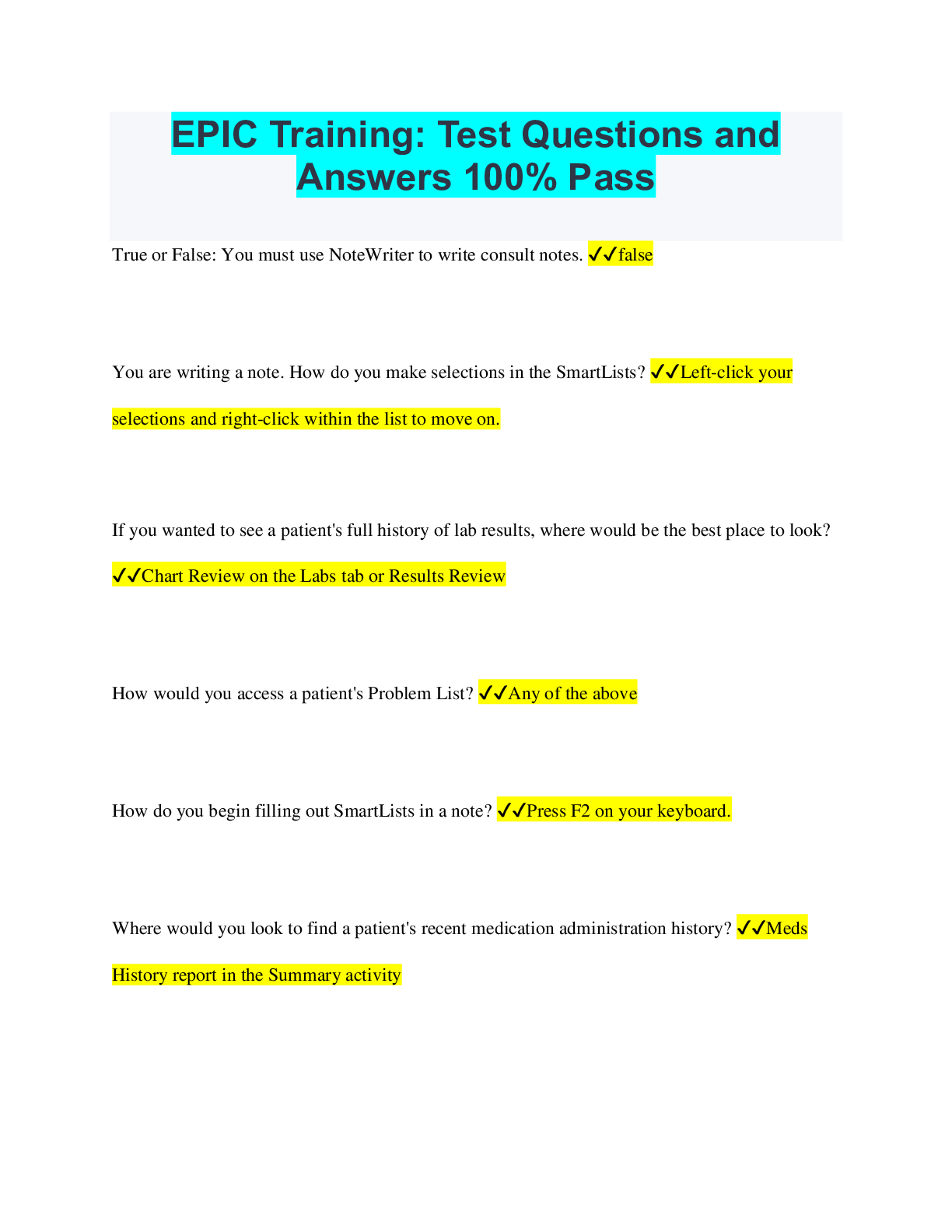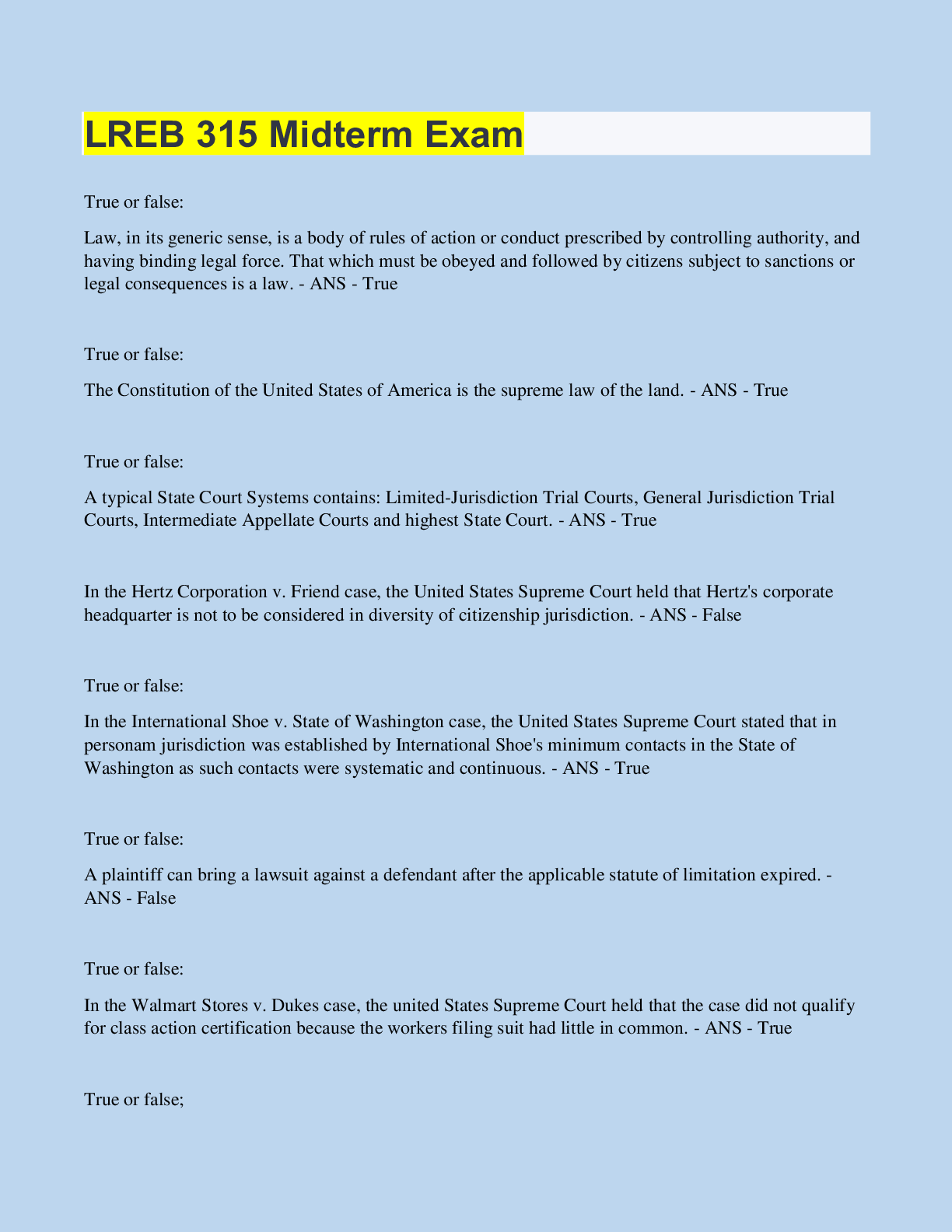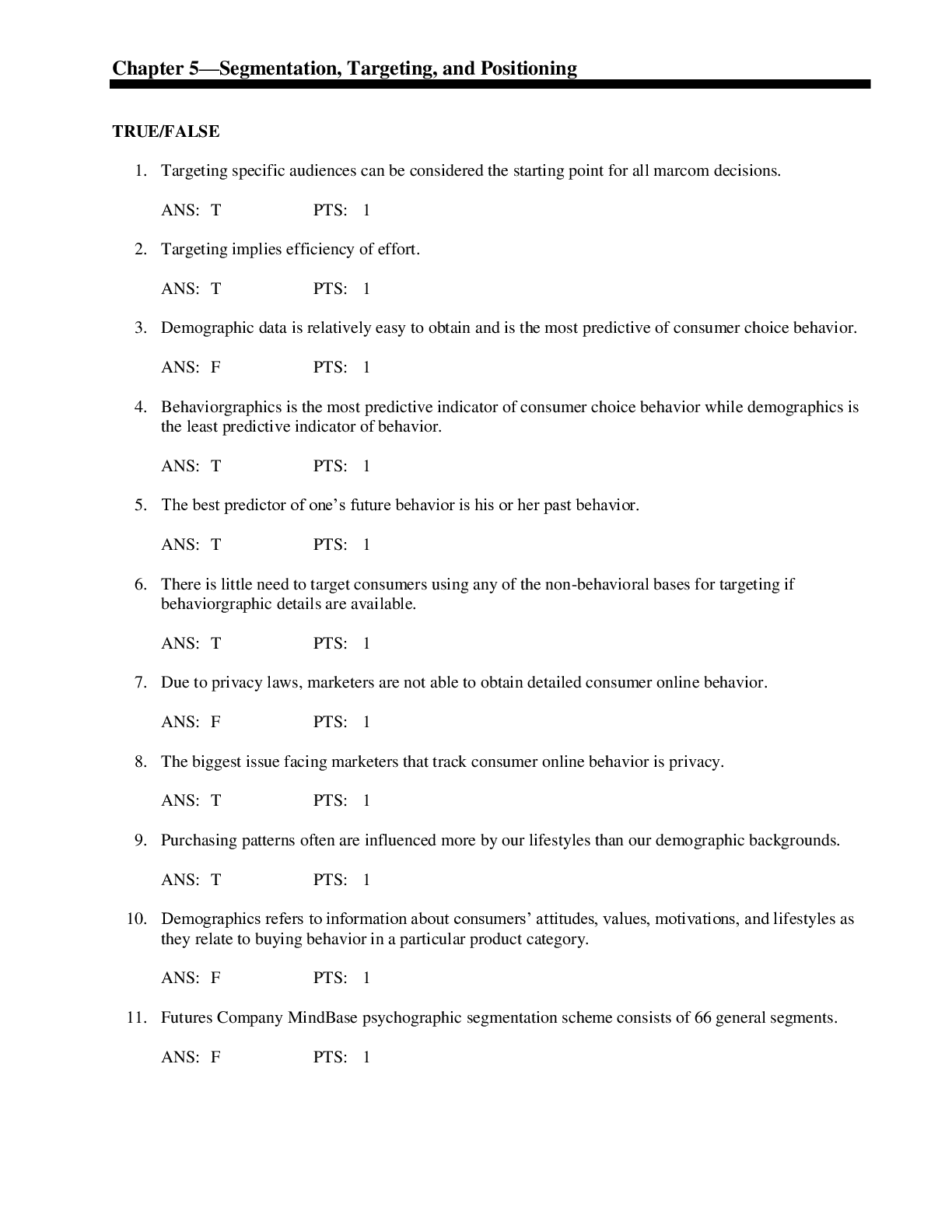Health Care > QUESTIONS & ANSWERS > CEFM Test Questions and Answers Already | 100% Passed (All)
CEFM Test Questions and Answers Already | 100% Passed
Document Content and Description Below
CEFM Test Questions and Answers Already Passed The paper speed used with EFM in North America is: a. 1cm/min b. 2cm/min c. 3cm/min ✔✔C. 3cm/min The US transducer on the EFM measures the a. ... Electrical signal of the fetal heart b. Mechanical movement of the fetal heart reflected off of sound waves c. R to R intervals of the fetal heart ✔✔b. Mechanical movement of the fetal heart reflected off of sound waves The purpose of the autocorrelation in external monitoring is to a. Compare incoming waveforms for comparison b. Decrease signal to noise levels c. Distinguish fetal from maternal heart rate ✔✔a. Compare incoming waveforms for comparison The area of maximum intensity of FHR is usually the fetal a. Back b. Chest c. Umbilicus ✔✔a. Back Palpating the uterus is best performed by using the a. Back of hand b. Fingertips c. Palm ✔✔B. Fingertips What is the most sensitive method of assessing uterine activity? a. Intrauterine pressure catheter b. Manual palpation c. Maternal perception ✔✔a. Intrauterine pressure catheter When educating the patient about fetal monitoring, the most appropriate statement is a. A normal tracing indicates that your baby is well-oxygenated b. A normal tracing indicates that you have a healthy baby c. Continuous fetal monitoring will insure a better outcome for your baby ✔✔a. A normal tracing indicates that your baby is well-oxygenated In comparison to maternal blood, the affinity of fetal blood for oxygen is a. Higher b. Lower c. The same ✔✔a. Higher The process that requires energy to accomplish the passage of substances within the intervillous space is a. Active transport b. Diffusion c. Facilitated diffusion ✔✔a. Active transport The umbilical vein carries a. Carbon dioxide from the fetus back to the placenta b. Deoxygenated blood from the fetus to the placenta c. Oxygenated blood from the placenta to the fetus ✔✔c. Oxygenated blood from the placenta to the fetus Fetal hypoxia is best described as a condition of a. Decreased oxygen in the blood b. Decreased oxygen in the tissue c. Increased hydrogen ions in the blood ✔✔b. Decreased oxygen in the tissue Stimulation of the PNS causes the FHR to a. Decrease b. Increase c. Remain the same ✔✔a. Decrease Chemoreceptors respond mainly to changes in a. Blood pressure b. Hormonal leves c. Oxygen and CO2 levels ✔✔c. Oxygen and CO2 levels The fetus responses to a significant drop of PO2 by a. Increasing oxygen consumption b. Reducing lactic acid production c. Shifting blood to vital organs ✔✔c. Shifting blood to vital organs Activation of fetal peripheral chemoreceptors results in which FHR change a. Decrease b. Increase c. No change ✔✔a. Decrease A patient receiving oxytocin has 17 ctx in 30 minutes, according to the NICHD guidelines this is called a. Hyperstimulation b. Hypertonus c. Tachysystole ✔✔c. Tachysystole Maternal supine hypotension is caused mainly by compression of the a. Inferior vena cava b. Spiral arteries c. Uterine vessels ✔✔a. Inferior vena cava Which factor influences blood flow to the uterus? a. Fetal arterial pressure b. Intervillous space flow c. Maternal arterial vasoconstriction ✔✔c. Maternal arterial vasoconstriction BMZ given to the mother can transiently affect the FHR by a. Decreasing the variability b. Increasing the variability c. Lowering the baseline ✔✔a. Decreasing the variability A FHR change that can be seen after administration of butophanol (Stadol) is a. Bradycardia b. Marked variability c. Sinusoidal-appearing ✔✔c. Sinusoidal-appearing Which one of the following statements reflects the predictability of fetal monitoring tracings? a. A category II tracing is highly predictive of a poorly oxygenated fetus b. A category I tracing is highly predictive of a well oxygenated fetus c. There is no difference in the predictability of a category I, II, or III tracing ✔✔b. A category I tracing is highly predictive of a well oxygenated fetus One FHR pattern that is associated with an abnormal acid-base status is a. Minimal variability with no accels or decels b. Recurrent variable decels with absent variability c. Tachycardia with absent variability ✔✔b. Recurrent variable decels with absent variability The NICHD definitions are applicable to a. Antepartum only b. Antepartum and intrapartum c. Intrapartum only ✔✔b. Antepartum and intrapartum A wandering FHR baseline may be indicative of a. Fetal seizure activity b. Impending fetal death c. Maternal medication administration [Show More]
Last updated: 6 months ago
Preview 3 out of 15 pages

Loading document previews ...
Buy this document to get the full access instantly
Instant Download Access after purchase
Buy NowInstant download
We Accept:

Also available in bundle (1)
.png)
NCC EFM Bundled Exam Questions and Answers with Verified Solutions
NCC EFM Bundled Exam Questions and Answers with Verified Solutions; All Graded A+
By Nutmegs 2 years ago
$20
10
Reviews( 0 )
$10.00
Can't find what you want? Try our AI powered Search
Document information
Connected school, study & course
About the document
Uploaded On
Aug 16, 2022
Number of pages
15
Written in
Additional information
This document has been written for:
Uploaded
Aug 16, 2022
Downloads
0
Views
393

.png)
























